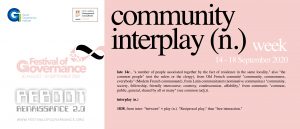Community interplay
25 September 2020

The UK is moving from a narrow and competitive model of healthcare, in which hospital was pitched against hospital, towards a system in which health, social care and other agencies work collaboratively for the benefit of citizens.
It’s a complex shift that will only succeed if the regulatory, cultural, legal and financial incentives governing the behaviours of organisations are reformed – and if those organisations find new and better ways to interact with each other and with the people they exist to serve.
Exploring these complexities of community interplay was the theme of the third week of our 2020 Festival of Governance.
The rise of integrated care
The confirmation in May this year of integrated care systems (ICSs) covering the whole of Yorkshire, all of London south of the Thames, the whole of Sussex, and another in Hertfordshire and West Essex, brought the total number of English ICSs to 18, serving around half of the population. And although there’s an argument that focusing resources on further integration during the pandemic period might not be the wisest course of action, it will surely follow in due course.
The goal of ICSs is to coordinate services better, spending more on keeping people healthy and out of hospital. People living in ICS areas should have a wider range of services closer to where they live or work, and those who need to use multiple services only have to deal with one team, who have a better understanding of the big picture.
This approach depends on effective partnerships between organisations and on excellent communication and engagement, both between organisations and also between citizens and care providers.

The NHS shuts its doors
The NHS has always been a 24-hour organisation and its doors have always been wide open. But this laudable accessibility has caused problems: people like to go where they know they’ll get service, even if the service they need doesn’t really require the input of a qualified doctor. Sometimes they would be better served by speaking to a counsellor, or a housing officer, or a social worker.
The establishment of local sustainability and transformation partnerships (STPs) and then integrated care systems (ICSs) was, in part at least, designed to encourage people away from expensive A&E departments towards places where they could get better, faster, cheaper care that was better suited to their needs. It was a big shift and, like all big shifts, it was moving slowly.
Then along came COVID-19 and suddenly the NHS became less accessible. In April this year, visits to A&E departments in England fell by 57% compared to 2019. This prompted a well-documented move towards digital solutions that included virtual consultations – a theme that was explored during one of our week’s events, a virtual conference hosted by Convenzis: The Next Generation of NHS Care: Healthcare Digital Technology.
But it wasn’t all about digital technology. In one of our COVID-19 daily bulletins, we looked at some of the measures taken by progressive local authorities such as Hastings Borough Council, which set up a community hub combining the resources of the NHS, the borough and county councils, Sussex Police, social housing providers, charities, business support initiatives and community groups to offer holistic support to its citizens.
Other initiatives covered in our bulletin series included the rapid repurposing of primary healthcare properties by Primary Health Properties to support frontline staff in the fight against the pandemic.
On Wednesday last week we worked with PHP to present The potential of primary care estate, in which we launched a joint paper about primary care estate and its commissioning after COVID-19.
Our white paper Innovative capital solutions to achieving STP goals, explores the national policies and governmental bodies which are driving the integration of services in the NHS, providing an overview of some of the estates challenges to delivering whole system transformation. It also offers a series of possible solutions to the estates challenge, highlighting ways to access funding and modernise property.
Moving to a more integrated world
Looking ahead, there’s a clear need to address the legal, regulatory and financial incentives that govern the mergers that are needed for further integration. These mergers are complicated and painstaking and they’ve survived so far largely thanks to goodwill and cooperation – but the rules governing them are still geared towards the old, competitive model.
On Thursday, we explored these issues in another jointly-hosted event, this time with legal firm Browne Jacobson. Topics covered in the wide-ranging discussion included whether goodwill alone is sufficient to hold together a healthy ICS or if some form of legislation is inevitable – another topic we covered in one of our bulletins: Time to legislate.
While trust and harmony are in place, legislation might just get in the way or even hold the partners back – but when trust and harmony break down, it might be essential. The ‘peer-to-peer’ approach being developed across ICSs depends on strong, trusting relationships – perhaps these are ultimately more important and desirable than any legislative framework.
The importance of trust and goodwill extends beyond the partners of an integrated care system to the people it exists to care for. The success of new structures and new approaches depends greatly on public buy-in – and that won’t happen without proper engagement.
On Friday, GGI’s Director of Communications Stephen McCulloch performed a multi-tasking tour de force with his Cooking and the community voice event, during which he talked about the importance of community engagement while cooking a rustic ribolitta, a hearty Italian dish that is somewhere between a soup and a stew.
The uncharitable observer might have seen the event as nothing more than a good excuse for Stephen to cook his lunch while delivering a talk but there was more to it than that, as Stephen explained: “One of the key elements of effective community engagement is considering how different people like to be connected with. I love food and cooking so the way to engage me is through my stomach. It’s always worth thinking creatively about how best to make that all-important connection with the people you’re trying to reach.”
Food brings people together and it was good to remember other successful community engagement initiatives that also fed people as they were doing so.
Stephen pointed to King’s Fund research that showed a link between good employee engagement and positive health and satisfaction outcomes for patients. There’s also evidence that organisations with a strong recognition of their accountability towards people and place – individual stakeholders and local communities – are more successful at achieving their strategic goals.
Community interplay or free interaction and integration makes sense locally – especially in smaller communities where the financial incentives are immediately clear. It’s one of many topics that was also addressed during this week’s Festival of Governance annual lecture on Tuesday, delivered by Rob Whiteman CBE, chief executive of the Chartered Institute of Public Finance and Accountancy (CIPFA), who spoke about Who’s responsible for what? Exploring the lines between government, governance, the public and third sectors.
For further advice or comment, please get in touch with us for free advice@good-governance.org.uk
Further reading
We touched on these issues many times during our bulletin series. Here are a few particularly relevant examples.
- A new deal on regulation
- Time to legislate
- Flexible property use
- System thinking at Hastings community hub
- Dudley integrates to innovate
- Defining communities
- Engaging with the hard-to-reach
